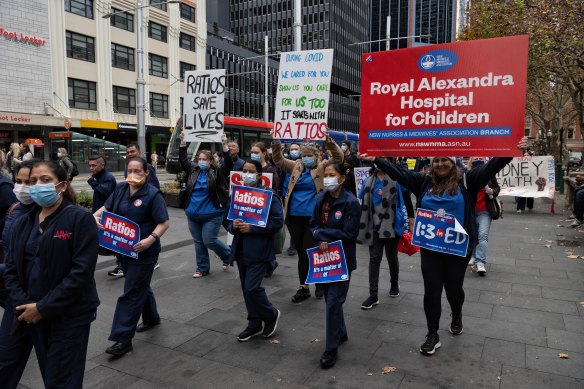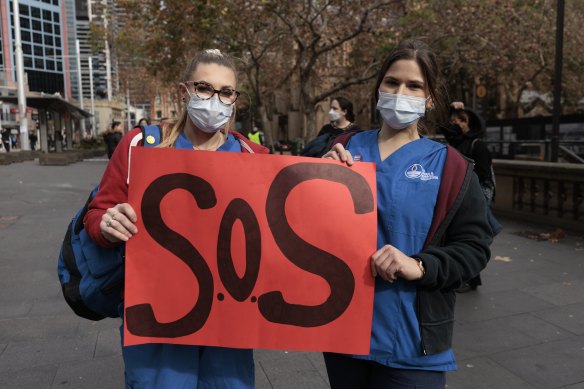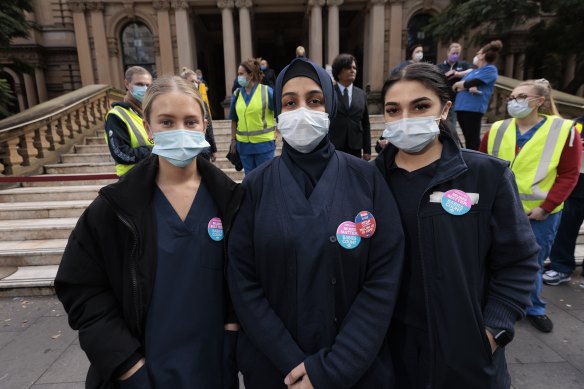This was published 2 years ago
Nurses increase their pay claim, warn of further strike action
By Mary Ward
Nurses and midwives have warned of further industrial action after upping their pay claim and doubling down on demands for changes to staff-to-patient ratios.
General secretary of the NSW Nurses and Midwives’ Association Brett Holmes said the majority of members had voted at a meeting on Tuesday to increase the desired wage rise to 7 per cent, well above its previous claim of 4.75 per cent and more than double the 3 per cent increase offered to public service employees.

Unionised nurses and midwives arrive at Sydney Town Hall for their meeting on Tuesday.Credit: Nick Moir
“They have worked extraordinarily hard for every member of this community, trying to keep them safe, and the government’s attitude is: take a pay cut,” Holmes said.
The union is also continuing to push for staff-to-patient ratios to be implemented on a shift by shift basis, a change Health Minister Brad Hazzard warned could result in some wards closing.
“The minister is talking out of his hat,” Holmes said, noting the same model had been implemented in Queensland.
Hazzard said the pay increase being given to the state’s nurses was “the highest in the nation”.
Nurses and midwives from 80 NSW hospitals walked off the job for periods of between one and 24 hours on Tuesday, in violation of an Industrial Relations Commission order obtained by the state government on the weekend.
The strike lasted 24 hours at Liverpool and Bankstown hospitals. Nurses and midwives walked off the job for 12 hours at Westmead, Blacktown, Campbelltown, and Royal Prince Alfred hospitals.
Last week, the union expressed frustration with a lack of clarity around NSW’s budget announcements, wanting to know exactly how many new nurses and midwives would be hired and where they would be stationed.
“All those extra numbers the government talked about mean nothing if they can’t be counted at the bedside,” Holmes said.
The Town Hall meeting was also broadcast online and to regional gatherings on the Central Coast, and at Coffs Harbour, Newcastle, Tamworth, Tweed Heads, Wollongong and Wagga Wagga.

Royal Prince Alfred nurses Georgia Armstrong, left, and Robyn Pavloudis at Tuesday’s meeting.Credit: Brook Mitchell
Outside, Robyn Pavloudis, a drugs and alcohol nurse at Royal Prince Alfred, said she was one of the more senior people in her unit, despite being relatively new to the field.
“Everyone else has just come back from working in the COVID [vaccination] clinics, and the COVID wards. So, I’m having to teach people, while I am still learning,” the 29-year-old said.
Union organiser Georgia Armstrong said Sydney Local Health District, which includes Royal Prince Alfred and manages multiple pandemic responses including the Sydney Olympic Park vaccination centre, was experiencing staff shortages “way worse” than last year.

Auburn midwives Olivia Enderson, Muskan Chnonyin and Rayhana Mohammad at Sydney Town Hall.Credit: Brook Mitchell
Auburn theatre nurses Audrey Figues and Lisa Phillips were frustrated by the state government’s promise to clear the elective surgery backlog. They said they were already working multiple double shifts a week, and have been told their workload will increase as hospitals overbook surgery lists to cover cancellations and reduce waitlists.
“If you’d asked me how long I would be in nursing five years ago, I would have said 15 years. Now it is, like, two years,” Figues said.
Midwives from Auburn and Campbelltown said the population growth near their hospitals was outpacing resourcing. The union wants babies to be included as patients when determining staffing ratios. They are currently not counted.
At Bankstown, where members voted for industrial action for the full 24 hours, branch president Cassandra Radford said cost of living pressures were also taking a toll.
“Getting paid below inflation is going to get more and more untenable for a lot of nurses,” she said.
The strike on Tuesday coincided with industrial action by rail workers which is set to continue throughout the week, and preceded a strike by public and Catholic school teachers on Thursday.
Our Breaking News Alert will notify you of significant breaking news when it happens. Get it here.